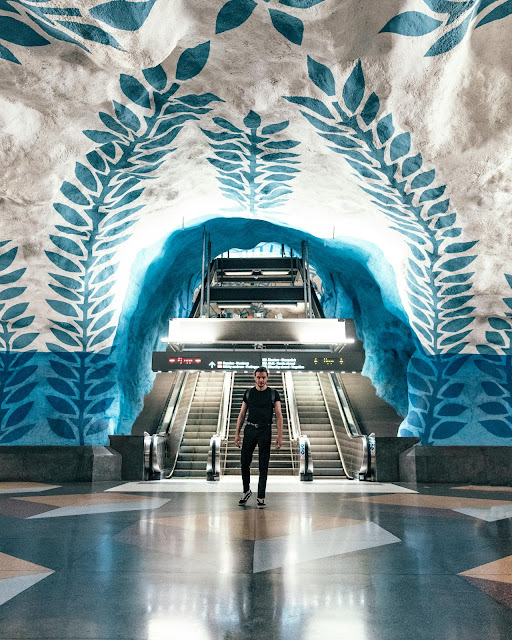 |
| Photo by Laurin Berli on Pexels |
Hello and welcome to Day 18 of July's UBC, Today, let's take a metro ride! Not because we need to go someplace but because we want to admire the stages of our journey.
Stockholm’s metro system isn’t just a way to get around; it’s an incredible, immersive art experience. Often called the world’s longest art gallery, over 90 of its 100+ stations showcase unique artworks, turning daily commutes into cultural journeys beneath the city streets.
 |
| Photo by Floriana on Pexels |
The Story Behind Stockholm’s Metro Art
The idea to decorate the metro with art began in the 1950s, shortly after the metro opened in 1950. The city wanted to make underground spaces more inviting and accessible, bringing art out of museums and galleries and into everyday public life.
Instead of bland, functional stations, the vision was to create vibrant spaces that everyone could enjoy — art that connected to local culture, history, and community.
How Artists Were Chosen
The project was initiated by the Stockholm city council and the Stockholm Transport Authority.
Artists were selected through commissions and open competitions.
Both established Swedish artists and emerging talents contributed.
Artworks are often site-specific, designed to reflect each station’s architecture, location, or history.
Styles range from modern abstract to figurative and historical themes.
The project was initiated by the Stockholm city council and the Stockholm Transport Authority.
Artists were selected through commissions and open competitions.
Both established Swedish artists and emerging talents contributed.
Artworks are often site-specific, designed to reflect each station’s architecture, location, or history.
Styles range from modern abstract to figurative and historical themes.

Photo by Ruslan Khimrad on Pexels

The Meaning and Message of the Art
Stockholm’s metro art stands for the democratization of art, bringing beauty, culture, and inspiration to people’s everyday routines.
The artworks often explore themes like:
Swedish culture and history
Nature and the environment
Social issues and urban life
Many stations tell stories or evoke moods, whether celebrating nature with bright, organic shapes or highlighting industrial themes. The art helps turn the daily commute into a memorable, uplifting experience, breaking the monotony of underground travel.
Fun Facts
The artworks span about 110 kilometers (68 miles) of tunnels
Famous stations include:
Kungsträdgården, known for its archaeological theme
Solna Centrum, famous for dramatic red cave-like walls (picture above)
The metro art project is a major tourist attraction, drawing visitors worldwide.
The artworks span about 110 kilometers (68 miles) of tunnels
Famous stations include:
Kungsträdgården, known for its archaeological theme
Solna Centrum, famous for dramatic red cave-like walls (picture above)
The metro art project is a major tourist attraction, drawing visitors worldwide.
Spotlight on Some Iconic Stations
Gullmarsplan Metro Station
Features vibrant ceramic artwork by Jesper Nyrén inspired by microscopic mineral structures, transformed into large-scale geometric designs. These colorful ceramics decorate the station entrances, bridging the underground with nature.
T-Centralen (The Central Station)
One of Stockholm’s most iconic and photographed stations, featuring blue-and-white leaf and vine motifs painted directly onto bedrock by artist Per Olof Ultvedt (1975). The calming natural patterns soothe commuters at the bustling hub where all three metro lines intersect — the heart of the subway and a perfect place to start exploring.
 |
| Photo by Spencer Davis on Pexels |
Stadion Metro Station
(Picture on the very top of this post)
Famous for its vivid blue cave-like walls and a striking rainbow arch symbolizing unity at the 1912 Olympics. Created by Åke Pallarp and Enno Hallek, the design brings light, optimism, and a spirit of inclusion — especially during Stockholm Pride. feghjz
Stockholm’s metro art is a remarkable example of how public spaces can be transformed through creativity. It invites locals and tourists alike to experience art in unexpected places, turning the underground into a vibrant cultural archive that reflects the city’s heritage and imagination.
Which theme would you want to see reflected in a metro station near you?

What a beautiful way to brighten a daily commute. The blue and white station is very striking!
ReplyDeleteNo doubt, these metro stations are pure artistic genius. What a way to feed your senses during times of travel. In-joy it-never take it for granted!!
ReplyDeleteOMG I love the cave look and the blue and white is awesome! I looks like some may miss the metro just from admiring all the beauty around the station.
ReplyDeleteI am so impressed with the artwork and the city. It is uplifting to know that somewhere, someone have taken so much care and planning to make commuting and life a little more pleasant.
ReplyDeleteWow, what a great idea! I wish that would happen here in America. My favorite art is that first picture, with the rainbow!
ReplyDelete